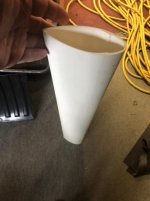skywagon8a
MEMBER
SE Mass MA6
courierguy, will you try one more test? Using the same piece of streamlined tubing, reverse it so that the thin pointed edge is facing into the wind. Compare that reading to the one you already tried. According to Prof Shapiro in #59's video the drag should be higher.









